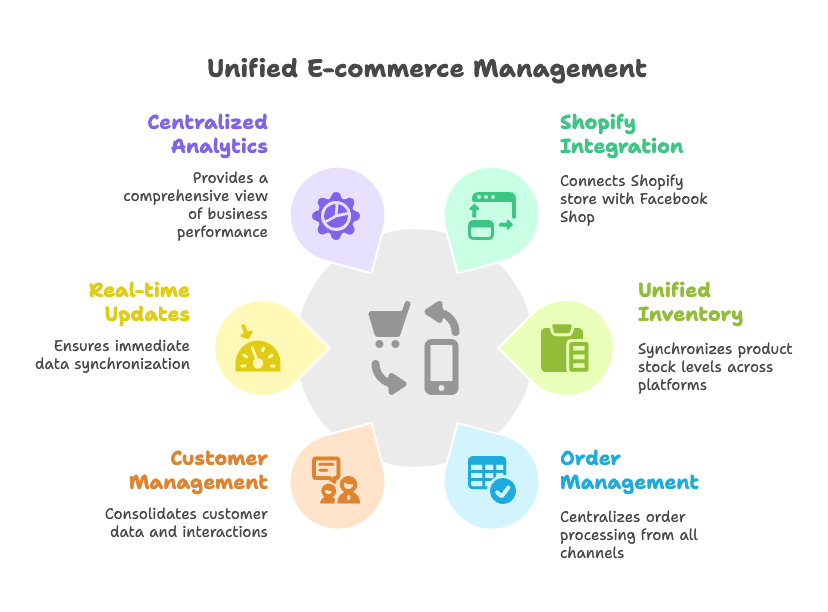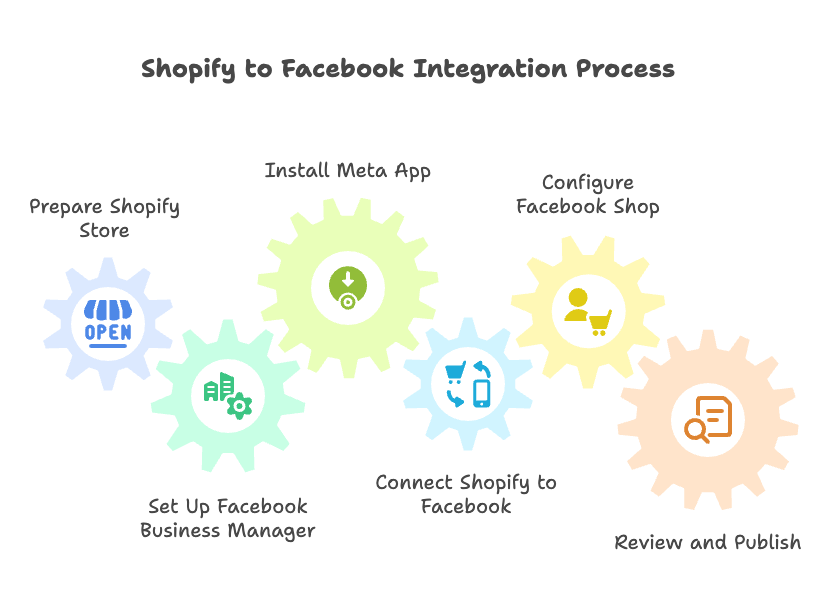Picture this: you’ve built an amazing Shopify store, but your customers are scattered across the web. They’re scrolling Facebook, discovering products, and then… leaving. What if you could meet them exactly where they already spend their time?
That’s the power of Facebook Shop integration with Shopify. It’s not just another sales channel—it’s your gateway to Facebook’s massive global audience, complete with seamless shopping experiences that keep customers engaged from discovery to checkout.
In this comprehensive guide, you’ll discover how to bridge your Shopify store with Facebook’s commerce features. We’ll walk through every step of the integration process, share troubleshooting tips that actually work, and reveal advanced strategies that successful merchants use to maximize their results. By the end, you’ll have everything you need to transform casual Facebook browsers into loyal customers.
Understanding Facebook Shop Integration

What is a Facebook Shop Integrated with Shopify?
A Facebook Shop integrated with Shopify creates a powerful bridge between your product catalog and Facebook’s e-commerce ecosystem. Think of it as your Shopify store’s twin living on Facebook—but with a crucial difference.
This isn’t just about posting product photos and hoping for the best. The integration creates unified inventory, order, and customer management systems that work together seamlessly. When someone buys from your Facebook Shop, that order flows directly into your Shopify admin alongside your other sales channels.
How does this compare to other Facebook sales approaches? Traditional methods like Facebook Marketplace or basic Page Shop tabs require manual management and separate workflows. You’re essentially running two different stores. But with Shopify integration, everything stays synchronized automatically—inventory levels, product details, pricing, and customer data all update in real-time across both platforms.
Key Features and Advantages
The magic happens in the details. Your products sync automatically between Shopify and Facebook, which means no more late-night inventory updates or embarrassing overselling situations. Change a price in Shopify? It updates on Facebook instantly.
But here’s where it gets really interesting. All your business management stays centralized in Shopify. Orders from Facebook customers appear in your regular order dashboard. Customer messages flow through your existing support channels. Analytics combine to give you a complete picture of your business performance.
For your customers, the experience feels native to Facebook. They can browse your shop, send direct messages with questions, and complete purchases without feeling like they’ve been bounced between different platforms. You can customize branding, create collections, and design the shopping experience to match your Shopify store’s personality.
Prerequisites and Requirements
Shopify and Facebook Accounts
Before diving into integration, let’s make sure you have everything lined up correctly. Your Shopify store needs to be live and accessible—not password protected or in development mode. Facebook’s systems need to be able to crawl and verify your products.
On the Facebook side, you’ll need a Facebook Business Manager account connected to your business page. This isn’t optional. You need admin access to both, and here’s a crucial detail many merchants miss: the person setting up the integration must have admin permissions on all connected accounts.
You’ll also need a Facebook Ad Account and Facebook Pixel installed. Even if you’re not planning to run ads immediately, these tools provide essential tracking and analytics capabilities that make your Facebook Shop much more powerful. The Pixel especially becomes crucial for understanding customer behavior and creating retargeting campaigns later.
Don’t forget about Facebook’s Commerce Policies. Your products must meet their eligibility requirements—no restricted items, accurate descriptions, and proper categorization. It’s worth reviewing these policies before starting the integration process.
Platform and Regional Availability
Here’s something that trips up many merchants: Facebook Shop isn’t available in every country yet. Some regions only support Facebook ads, not the full Shop experience. Check Facebook’s commerce availability for your location before investing time in setup.
The good news? This integration works with all Shopify plans. Whether you’re on Basic Shopify or Shopify Plus, you can access the Facebook & Instagram by Meta app and create your shop.
Step-by-Step Integration Process

Preparing Accounts and Meeting Requirements
Start by double-checking your Shopify store’s public accessibility. Remove any password protection and ensure your products have clear, high-quality images and complete descriptions. Facebook’s review process scrutinizes these details carefully.
Next, set up your Facebook Business Manager properly. This means creating or connecting your business page, setting up an ad account, and ensuring all admin roles are assigned correctly. Many integration failures stem from permission issues that could have been avoided with proper initial setup.
Installing the Facebook & Instagram by Meta App
Ready for the actual integration? In your Shopify admin, navigate to Settings, then Apps and Sales Channels. Click the “+” button and search for “Facebook & Instagram.” Install the official Meta app—not third-party alternatives that might complicate your setup.
Now comes the connection process. You’ll pair your Shopify store with your Facebook Business assets: Business Page, Commerce account, Ad account, and Facebook Pixel. The system will ask for various permissions. Grant them. These permissions allow the deep integration that makes everything work smoothly.
Pay attention to the terms and conditions during this step. You’re agreeing to data sharing policies that affect how customer information flows between platforms. Understanding these agreements helps you communicate transparently with your customers about data usage.
Facebook Shop Configuration
Here’s where strategy meets execution. You don’t have to sync every product in your Shopify catalog to Facebook. Start by selecting your best-performing items or those most likely to appeal to social media shoppers.
Think about your product organization carefully. Create collections that tell a story or solve specific problems for your Facebook audience. A “Quick Gifts Under $25” collection might perform better on Facebook than your technical “Category 3A Hardware” grouping.
Configure your data sharing settings thoughtfully. You want enough data flow to power effective remarketing and analytics, but you also need to respect customer privacy preferences. The Facebook Pixel integration is crucial here—it tracks customer behavior that becomes invaluable for future marketing efforts.
Review and Publishing
Facebook reviews every shop before approval. This process typically takes 24-48 hours, but can stretch longer during busy periods or if issues arise. Common rejection reasons include policy violations, incomplete product information, or website accessibility problems.
If your shop gets rejected, don’t panic. Facebook provides specific feedback about issues that need addressing. Fix the problems systematically and resubmit. Most merchants get approved on their second attempt if they carefully address the initial feedback.
Once approved, your Facebook Shop goes live. But going live doesn’t mean the work is done—it means the optimization phase begins.
Managing and Optimizing Your Facebook Shop
Day-to-Day Operations from Shopify Admin
The beauty of proper integration shows up in daily operations. Update a product in Shopify, and it automatically updates in your Facebook Shop. Change inventory levels, adjust prices, or modify descriptions—everything stays synchronized without manual intervention.
Orders from Facebook customers appear in your regular Shopify order dashboard alongside all your other sales. Customer inquiries through Facebook Messenger flow into your existing customer service workflow. This unified approach eliminates the complexity of managing multiple separate systems.
But integration goes deeper than just order processing. Customer support conversations that start on Facebook can continue via email through Shopify’s system. Purchase history, customer preferences, and communication records all combine to give you a complete view of each customer relationship.
Customization and Merchandising
Your Facebook Shop shouldn’t be a generic product dump. Create curated collections that highlight your bestsellers, seasonal items, or special promotions. Think like a visual merchandiser—which products work well together? What story does your product arrangement tell?
Take advantage of Facebook’s promotional tools. Tag products in your regular Facebook posts and Instagram stories. These tags become clickable links that drive traffic directly to your shop. When done thoughtfully, this approach feels helpful rather than pushy.
Leverage your advertising capabilities strategically. Your Shopify product catalog powers Facebook’s dynamic ads, which automatically show relevant products to people who have visited your store. This type of remarketing often delivers higher conversion rates than generic advertising approaches.
Analytics become your compass for optimization. Facebook Analytics combined with Shopify reports reveal which products resonate with social media shoppers versus other customer segments. Use this data to refine your product selection and merchandising strategy.
Troubleshooting and Best Practices
Common Issues and Solutions
Product sync errors frustrate many merchants, but most have straightforward solutions. If products aren’t appearing in your Facebook Shop, check the basics first: Are they published in Shopify? Do they meet Facebook’s commerce policies? Are the product images high-quality and properly formatted?
Account connection errors often stem from permission conflicts. If you’re getting admin access errors, verify that the same Facebook account has admin rights to your Business Manager, business page, and ad account. Mixed permissions create authentication problems that block proper integration.
Customer communication can become complicated when orders originate from Facebook but need support through Shopify channels. Establish clear processes for your team. Train customer service staff to access order details regardless of the original sales channel. Create templates for common Facebook-specific inquiries.
Optimization Tips and Advanced Uses
A/B testing becomes powerful with Facebook Shop integration. Try different collection arrangements, featured products, or promotional messages. Facebook’s large audience provides statistically significant results faster than testing on smaller channels.
Don’t limit yourself to Facebook alone. Instagram Shop integration happens simultaneously, giving you two social commerce channels with one setup process. Create cross-platform campaigns that leverage both audiences while maintaining consistent branding and messaging.
Privacy controls require ongoing attention. Balance your need for customer data with respect for privacy preferences. Transparent communication about data usage builds trust that leads to higher conversion rates and customer loyalty.
Advanced Strategies for Growth
Creating an Omnichannel Sales Ecosystem
The real power emerges when Facebook Shop becomes part of a larger omnichannel strategy. Your Shopify store acts as the central hub, but customers can discover and purchase through Facebook, Instagram, Google Shopping, and other channels seamlessly.
Inventory management becomes crucial as you scale across multiple channels. Shopify’s inventory tracking prevents overselling, but you need strategies for allocating stock across channels based on performance data. Monitor which channels drive the highest lifetime customer value, not just immediate sales volume.
Customer data unification provides competitive advantages. When someone browses your Facebook Shop but purchases later on your main site, you understand the complete customer journey. This insight informs decisions about where to invest marketing resources and how to optimize each touchpoint.
Retargeting and Loyalty
Facebook Pixel data becomes incredibly valuable for sophisticated retargeting campaigns. You can create audiences based on specific behaviors: people who viewed certain products, added items to cart but didn’t purchase, or completed purchases within specific timeframes.
Layer your retargeting strategy thoughtfully. Recent browsers might see product-specific ads, while past customers receive promotions for complementary items. This behavioral segmentation typically delivers higher ROI than broad demographic targeting.
Connect your Facebook Shop activities to broader loyalty programs. Customers who follow your Facebook page and shop regularly might qualify for special perks or early access to new products. This integration strengthens relationships across all touchpoints.
Measuring Success and Iterating
Success metrics for Facebook Shop go beyond immediate sales numbers. Track engagement rates, click-through rates from posts to shop, and customer lifetime value by acquisition channel. Some customers discovered through Facebook might make their first purchase elsewhere but become high-value repeat buyers.
Regularly analyze which products perform best on Facebook versus other channels. Social media shoppers often prefer different items than search-driven customers. Use these insights to optimize your Facebook product selection and inform your broader marketing strategy.
Refine continuously based on performance data. What collection arrangements drive the most engagement? Which promotional strategies convert browsers into buyers? Facebook’s large user base provides enough data to test and iterate quickly.
Conclusion and Next Steps
Recap of Key Benefits
Facebook Shop integration with Shopify delivers three transformative advantages. First, unified commerce management eliminates the complexity of running separate systems. Everything flows through your existing Shopify workflows, from inventory to customer service.
Second, you gain access to Facebook’s massive, engaged audience without sacrificing control over your customer experience. Your brand stays consistent while reaching people where they already spend time browsing and discovering new products.
Third, the operational efficiency gains compound over time. Automated syncing, centralized analytics, and integrated customer communications free up resources for strategic growth activities rather than manual administrative tasks.
Actionable Steps for Shopify Merchants
Start by completing the technical prerequisites we outlined earlier. Ensure your accounts have proper permissions and your store meets Facebook’s requirements. This foundation work prevents frustrating delays later.
Once integrated, resist the urge to set everything to autopilot. Continuously optimize your shop presentation based on performance data. Test different collections, promotional strategies, and product selections to find what resonates with your Facebook audience.
Finally, explore advanced features systematically. Instagram Shop integration, dynamic remarketing ads, and sophisticated customer segmentation become powerful tools as you master the basics. The merchants who succeed with social commerce treat it as an ongoing optimization challenge, not a one-time setup task.
References
- Shopify Help Center. “Facebook Shop.” Shopify. https://help.shopify.com/en/manual/online-sales-channels/facebook-instagram-by-meta/facebook-shop
- Shopify Help Center. “Setting up Facebook and Instagram by Meta.” Shopify. https://help.shopify.com/en/manual/online-sales-channels/facebook-instagram-by-meta/setup
- Shopify. “How To Create a Facebook Shop in 6 Simple Steps (2024).” Shopify Blog. https://www.shopify.com/blog/how-to-create-a-facebook-shop
- PageFly. “Shopify Facebook Shop: Setup, 12 Store Examples & Guide.” https://pagefly.io/blogs/shopify/shopify-facebook-shop
Ready to transform your Facebook presence into a revenue-generating sales channel? Growth Suite helps Shopify merchants like you optimize every aspect of their sales process, including smart discount strategies that convert social media browsers into buying customers. The app integrates seamlessly with your existing setup and uses AI-powered behavioral tracking to present the right offers at the perfect moments. Install Growth Suite with a single click and start seeing results from your Facebook Shop integration immediately!




